Katharine Sykes, "Symbolic Reproduction in Early Medieval England" (Oxford UP, 2024)
Description
Katharine Sykes joins Jana Byars to talk about her new book, Symbolic Representation in Early Medieval England (Oxford University Press, 2024). In the early Middle Ages, the conversion of the early English kingdoms acted as a catalyst for significant social and cultural change. One of the most visible of these changes was the introduction of a new type of household: the monastic household. These reproduced through education and training, rather than biological means; their inhabitants practised celibacy as a lifelong state, rather than as a stage in the life course. Because monastic households depended on secular households to produce the next generation of recruits, previous studies have tended to view them as more mutable than their secular counterparts, which are implicitly regarded as natural and ahistorical.
Katharine Sykes charts some of the significant changes to the structure of households between the seventh to eleventh centuries, as ideas of spiritual, non-biological reproduction first fostered in monastic households were adopted in royal households in the tenth and eleventh centuries, and as ideas about kinship that were generated in secular households, such as the relationship between genealogy and inheritance, were picked up and applied by their monastic counterparts. In place of binary divisions between secular and monastic, biological and spiritual, real and imagined, Sykes demonstrates that different forms of kinship and reproduction in this period were intimately linked.
Learn more about your ad choices. Visit megaphone.fm/adchoices
More Episodes
Published 11/23/24
During the early medieval Islamicate period (800–1400 CE), discourses concerned with music and musicians were wide-ranging and contentious, and expressed in works on music theory and philosophy as well as literature and poetry. But in spite of attempts by influential scholars and political...
Published 11/12/24
Filippo Gianferrari, "Dante's Education: Latin Schoolbooks and Vernacular Poetics" (Oxford UP, 2024)
In fourteenth-century Italy, literacy became accessible to a significantly larger portion of the lay population (allegedly between 60 and 80 percent in Florence) and provided a crucial means for the vernacularization and secularization of learning, and for the democratization of...
Published 11/06/24


